This is Part 2 of the Scouting NY tour of Rockland State Psychiatric Hospital, a 600-acre abandoned mental asylum complex in Orangeburg, NY. Be sure to check out Part 1 here!
Construction of Rockland State Psychiatric Hospital began in 1927 on a 600-acre plot in rural Orangeburg, NY. Below, the Male Reception Building in its prime…
…and today:
Very little has changed on the complex since its construction. In most cases, it’s only the overrun foliage that gives it away as abandoned. Below, building 19 then…
…and its twin, Building 18, now:
I love little details from a bygone era, like this TV antenna…
Also hidden behind a tangle of vines…
A sign identifying the building:
During the 1930’s, Rockland State was considered one of the best planned psychiatric hospitals in the world. Its numerous facilities, including a power plant, rendered it largely self-sufficient…
I’m not 100% sure, but the power plant appeared to be in working operation the day I toured the facility (correct me if I’m wrong on this one). I love that the endless smoke tower steps originally went right down to the ground (er, seems like a bad choice for a mental asylum):
And in case you weren’t sure which building this was, a helpful sign:
In fact, during its heyday Rockland boasted a working farm and numerous industrial shops, all of which were staffed by patients. Everything from furniture to brooms were produced on location…
And though most most of the hospital complex is abandoned today, many of the old maintenance offices are still in use…
From an on-site locksmith…
…to plumbing…
…carpentry, roofing, and a tinshop…
…to electric & refrigeration:
Behind the facilities offices, a great old ramshackle building:
I’m taking a guess here, but does this squat structure remind anyone else of a bus station? It’s located in the center of the complex and would make sense as its transportation hub:
One of the most well preserved buildings is the old Administration Building…
…which best exemplifies the Mediterranean-style architecture found all over the complex (sadly, the mission tile roofs are mostly hidden by snow in my pictures):
I love the terra cotta entrance…
Also very cool: two working lanterns on either side of the door. You can just make out the faded initials RPC, or Rockland Psychiatric Center:
Very glad to see the cupola is still in great shape after all these years…
…complete with its original weathervane!
Directly across from the old administration building is one of the last working hospitals on the complex, the modern Rockland Psychiatric Center. Effort was made to match the new structure to its surroundings, but it just goes to show that the old Rockland campus is an artifact of the past.
A side door to a building…
…with a schedule I have a feeling is no longer kept (yes, of course I pressed the doorbell):
Seems like the type of sign you’d see prominently around a mental asylum…
…however, this one was just on the old basketball court, in the center of the complex:
Also, note the building behind the basketball court. Another of my favorite buildings on the campus, this one resembles a stable and especially reminds me of my travels through Spain…
Love the enormous wooden doors and lanterns overhead:
Inside another building…
…a reception area, plus a lone pentagram:
Update! As a huge H.P Lovecraft fan, I can’t believe I didn’t catch this. Luckily, reader CSCottM pointed out a way too coincidental resemblance between the pentagram…
…and Lovecraft’s infamous Elder Sign:
As CScottM points out, very appropriate for an abandoned mental asylum. The other side of the room – looks like it was in use until fairly recently:
A peek into another building…
…reveals a former cafeteria…
…also in pretty good shape.
This facilities-related structure is surrounded by a stone fence…
A crumbling urn on one of the posts:
Inside, a mess. Those look like walk-in refrigerator doors on the right – perhaps a former kitchen?
Another look inside. Would love to know the story behind that playpen…
As I was driving past a far corner of the campus, I noticed a bunch of structures.
At first, I thought they might be graves – mental asylums often had on-site cemeteries for indigent patients:
On closer inspection, they’re just picnic tables!
I’d love to know if this is a newer addition, or if hospital workers used to gather here in the 40’s and 50’s for barbecues:
Sadly, much of the Rockland staff was drafted during World War II, leaving non-qualified workers to take their place. This resulted in just 1 psychologist for every 300 patients. Infection spread, and the hospital soon became drastically overcrowded.
As many of you pointed out, the harrowing conditions were documented in The Snake Pit, written in 1946 by Mary Jane Ward and based on her experiences incarcerated at Rockland State (a movie based on the book was not filmed at Rockland).
The title, according to the dust jacket, comes from an ancient form of psychiatric treatment in which patients were thrown into actual snake pits in the hope that their sudden terror would cure their mental illness.
Though presented as a fictional tale set at the Juniper Hill Asylum, The Snake Pit documents many of the very real forms of psychiatric treatment Ward experienced during her stay at Rockland. These included hydrotherapy, in which patients were forced into baths of either scalding or freezing water, electroshock therapy, insulin shock therapy, and of course, lobotomies.
At the time, very little anesthetic was used during lobotomies; in fact, there weren’t even teeth clamps to prevent patients from biting their tongues. Surgical equipment included drills with 1-inch bits.
By 1970, Rockland was largely an outpatient facility, and with the onset of psychotropic drugs, only now services the seriously ill.
I’m glad to report that Rockland State is not in immediate danger of being razed. A reader updated me that plans to turn it into a senior citizen community fell through last year, and the town is seeking new options.
I really hope Orangeburg decides to follow in the footsteps of Traverse City, Michigan, where an abandoned state hospital was saved through its conversion to commercial and residential space.
It’s unfortunate the sun only stayed out for the first few pictures I took – Rockland is one of those places that looks great when a blue sky backgrounds its red clay roofs…and very bleak under a recent snowfall and overcast skies.
I urge you to take a walk around the campus to enjoy it for yourself someday. It’s public property, so you won’t get in trouble (though entering buildings is illegal), and it’s literally a journey back in time. I promise, your imagination is going to have a field day with this place.
Finally, a look at the windows of Rockland State. I’m always fascinated by windows at mental asylums. For untold thousands of patients, these windows offered what must have been a torturous glimpse at a freedom they could not have.
-SCOUT
PS – Much of my history came from this short 1999 piece in the NY Times, and is definitely worth a read.

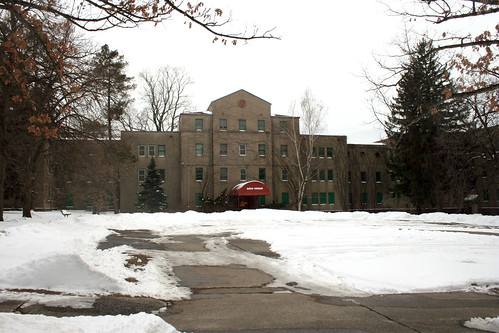

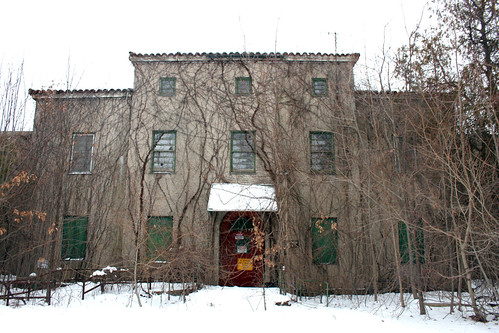



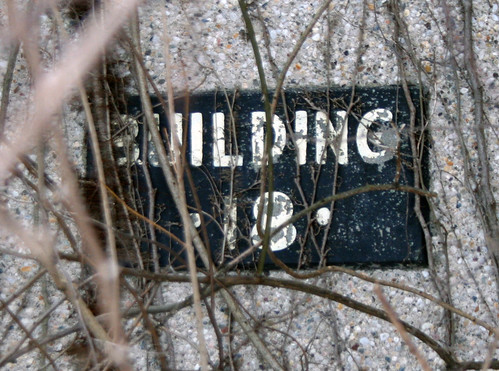
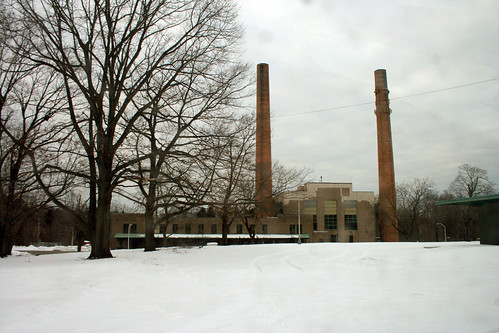
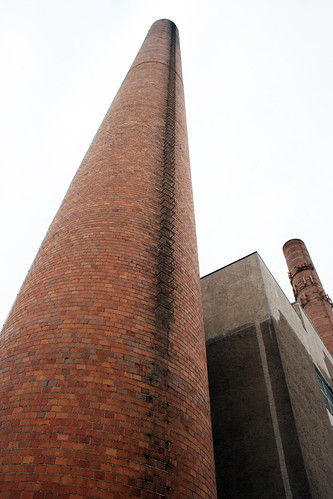

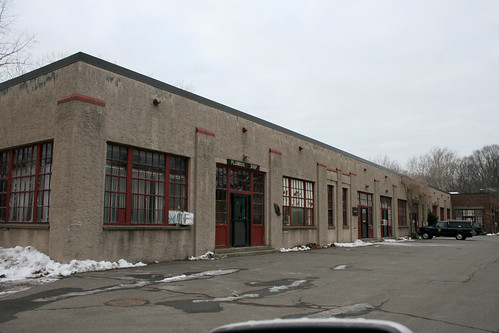

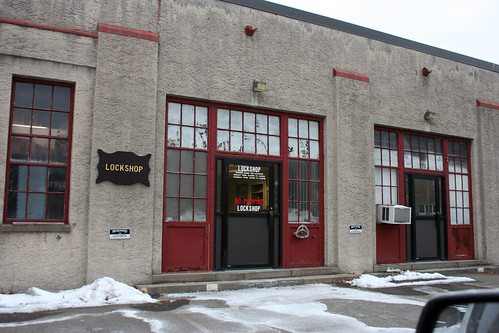

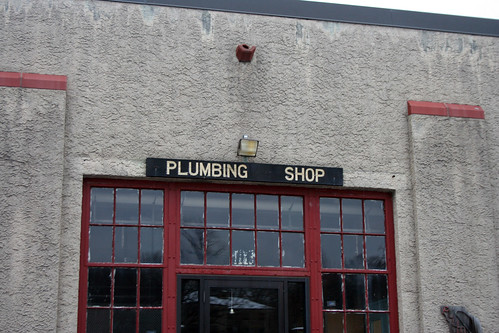
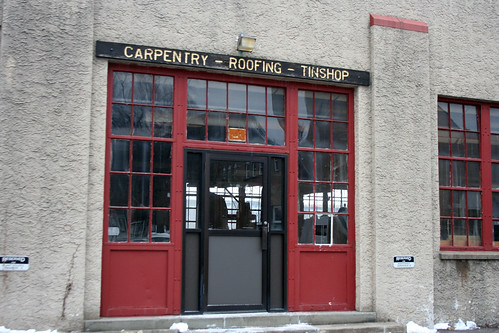

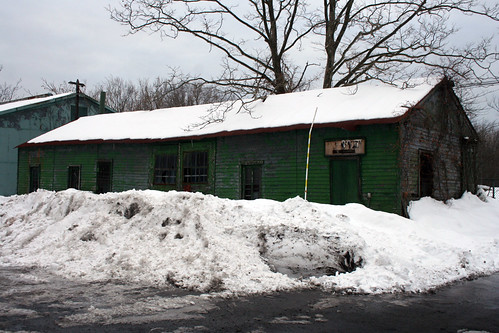
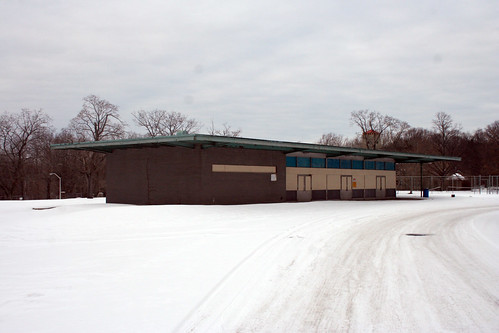
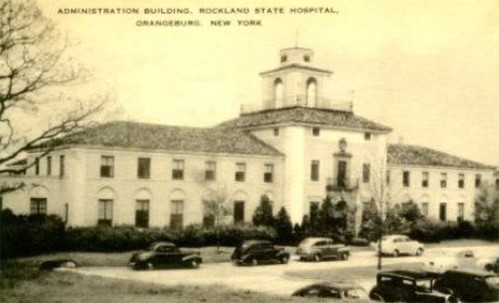


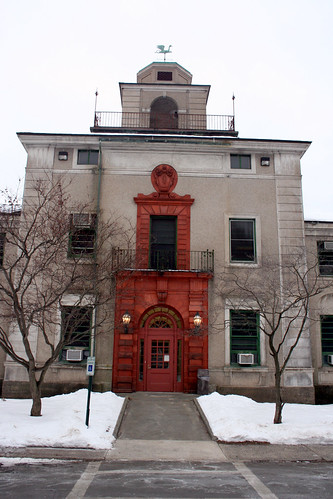
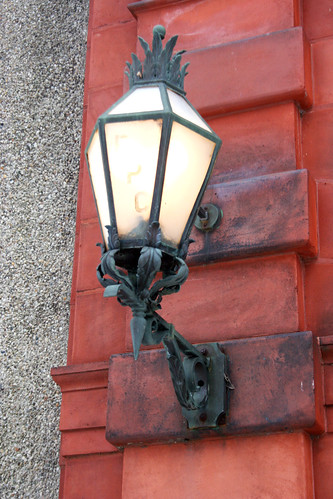
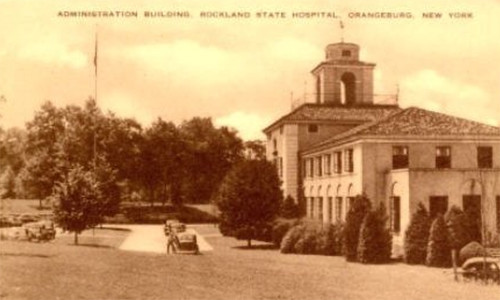
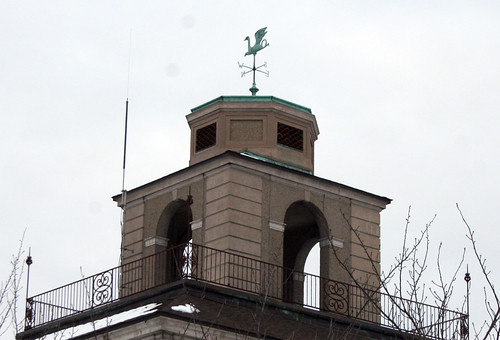
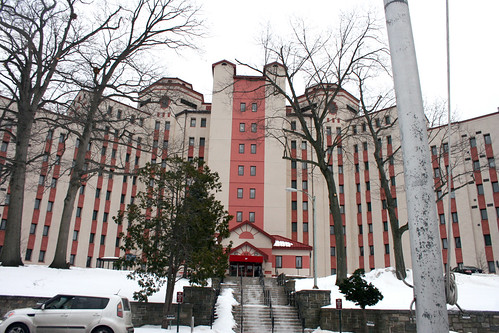


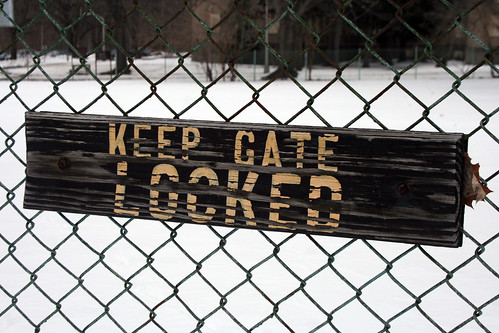
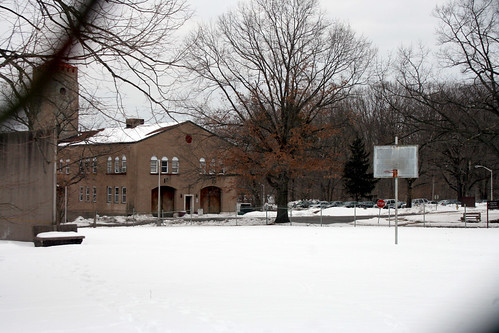

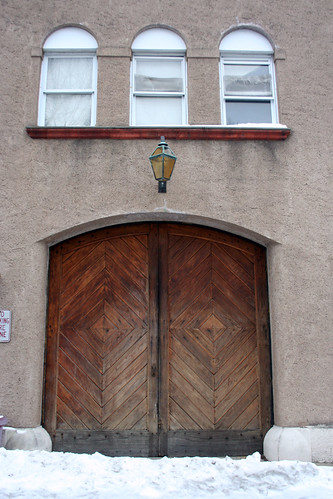
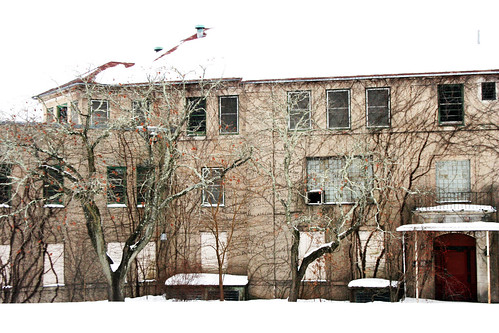
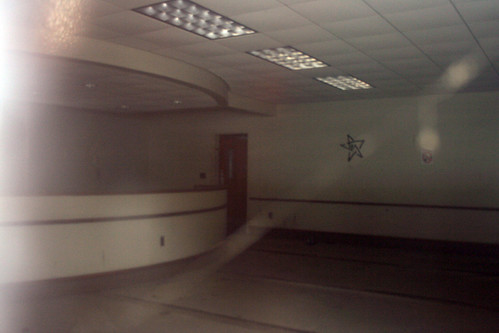
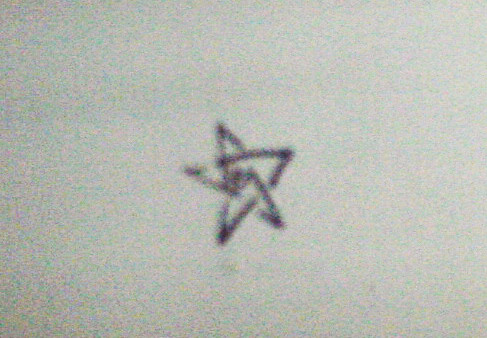

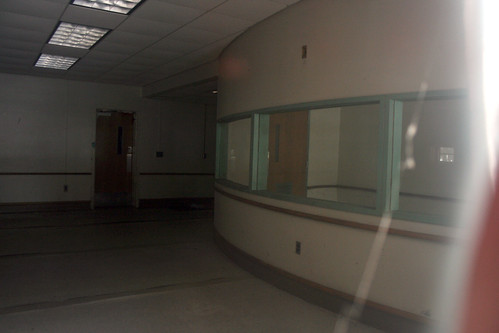

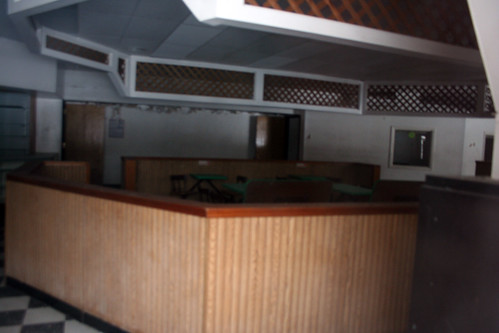

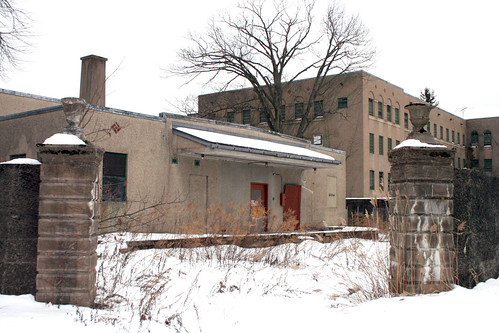

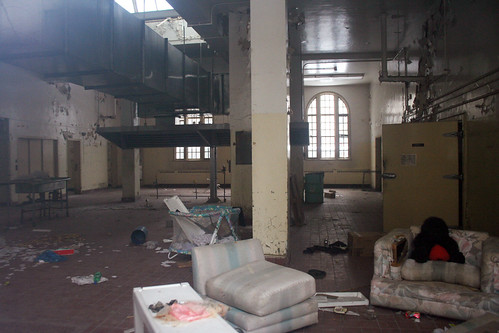
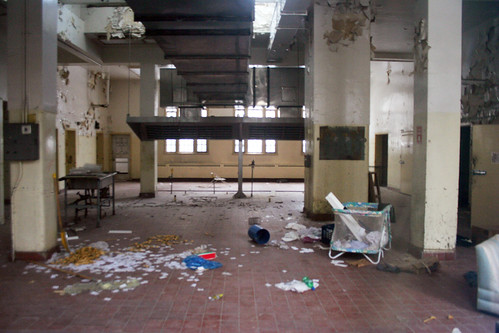

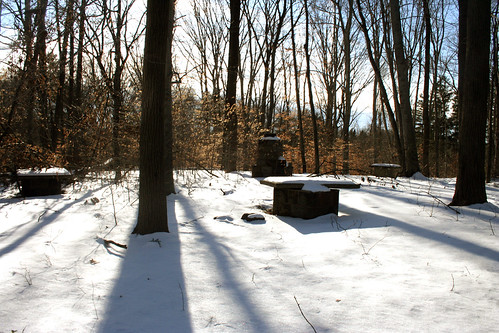
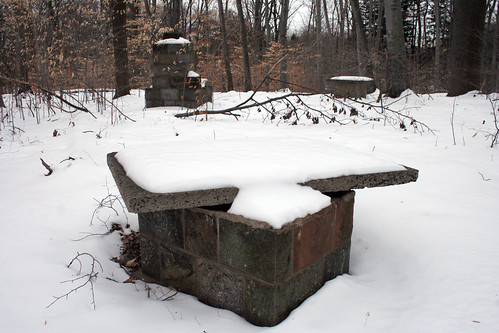
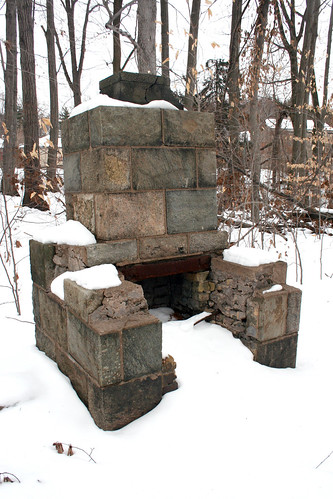
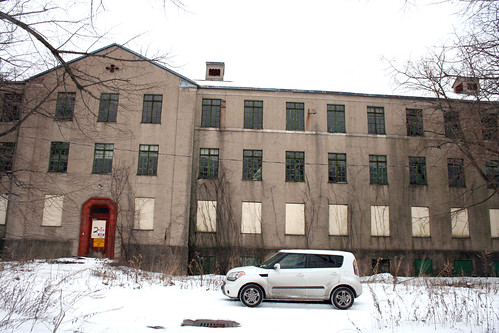
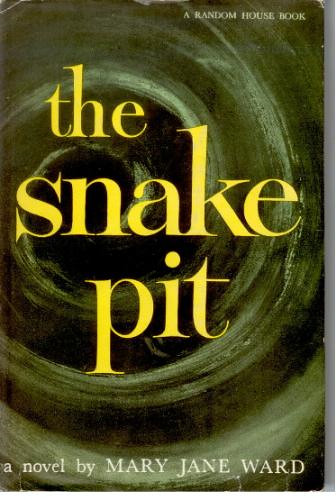

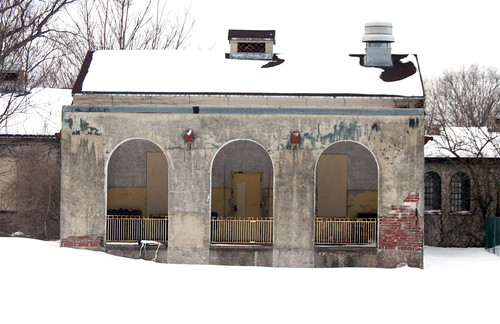


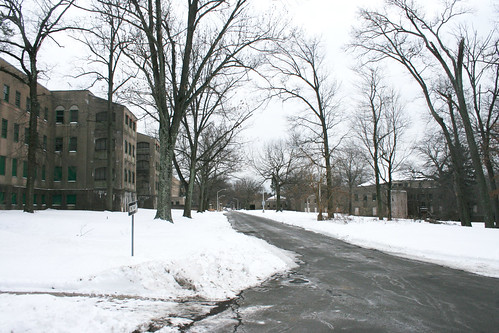
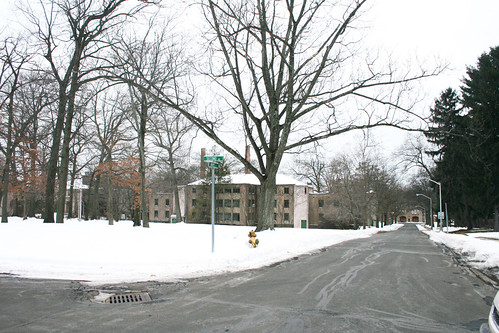
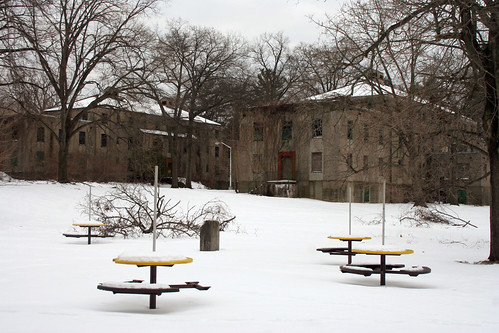

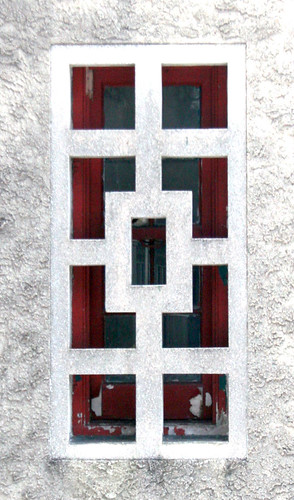



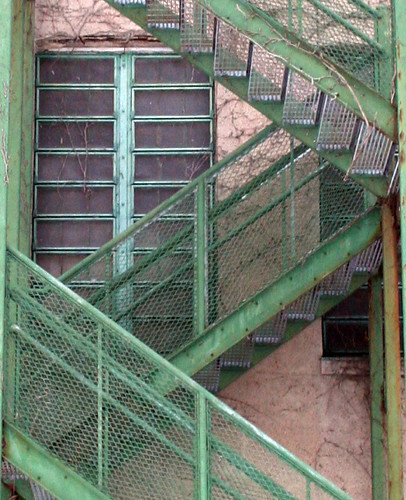

In the pictures with the playpen, it looks like squatters once lived there.
It’s likely explorers got in and trashed the playpen area…
The checkered black and white floor is part of the former Big Rock Cafe were patients and workers alike would go to get lunch or cigarettes.
The picture directly below with the stone fence that has crumbling urns used to be the animal shelter (before it was relocated to a different building). The entrance should actually form a u-shape so you could pull a car through and go out the other side of the twin set of stone urn fence.
The animal shelter was no kill and was run by volunteers, they ended up moving the location to a building off the main drag (technically off Old Orangeburg Rd inside the gates to a warehouse looking building).
What a great look back at some of the beautiful buildings that I used to love to look at back in the days when I was working for the animal rescue group that was allowed to shelter our dogs there; thanks to the people who allowed us to keep our dogs and cats there during the time. we were not adopting them out (on the weekends at a NJ PetSmart).
We all took shifts going there morning, noon and night 365 days of the year. We also had patients from the hospital to help us with cleaning, feeding, walking and loving the animals!
Many a rainy, day did I find this place a bit creepy, not to mention the passageways that ran below the buildings. I never felt it was haunted because the animals were always happy.
I hope the souls of those who suffered have passed on to a better place.
It was a pleasure to work there over the years.
This eerily reminds me of the Harlem Valley Psychiatric Center in Wingdale, NY. Have you ever been up there to photograph the grounds/buldings? It is not that far from the city (approx an hour and a half, and across the street from the “Harlem Valley-Wingdale” stop on Metro North Harlem Line).
Im not a big blog reader, but yours are always so interesting! You should consider a little trip to Pilgrim State Psych. Center (Brentwood, Long Island) It was totally self sufficient, a lot of it is still being used. They have a little museum too. There are so many dilapidated buildings and houses you totally get lost there.
Chances are good that there is a cemetery on the grounds. You may not have noticed it due to the snow cover; if it follows the model of the cemetery at Pilgrim State, there are no headstones, just numbered markers lying flush with the ground.
There were 3 cemeteries the original one is not that close to the buildings. There are about 1600 buried there. Small numbered markers
That red terracotta door way is stunning. So vibrant.
Also, I wanted to let you know about another psychiatric hospital re-purposed- Mimico Insane Asylum, later Lakeshore Psychiatric Hospital, and now Humber College’s Lakeshore campus, in Toronto
I was a student at Humber a couple years ago, in their Fundraising program, and they did an amazing job of modernizing the buildings, while keeping the architecture intact.
History: http://www.asylumbythelake.com/index.html
Now: http://www.flickr.com/search/?w=all&q=humber+college+lakeshore&m=text
(I can’t find a good gallery of pictures! But you get the idea).
I’ve always been fascinated by the history of buildings, and loved this aspect of going to this College.
Thanks for the fantastic blog!
Awsome pics, I love old psych centers! Your blog is very informitive.
Actually about the redevelopment: http://www.canadianarchitect.com/issues/story.aspx?aid=1000193809
Okay, I’m done!
The pentagram in the reception area looks a lot like an Elder Sign (http://en.wikipedia.org/wiki/Elder_Sign) from HP Lovecraft’s stories. Or a version of the sign, anyway. Very appropriate for a abandoned mental asylum!
Great eye, Scott – just added it to the post!
There’s a wonderful new coffee table book, Asylum, that documents the amazing facilities many of these hospitals once were. Entirely self sustaining, many had root cellars, fisheries, bakeries and farms on premises. This was before mental help became community based, and before Reagan eventually, like Thacher,threw the mentally disabled on the street, where many of them remain today. Still, Asylum, is a beautiful book, featuring beautiful, odd, and haunting photography.
Just in case you don’t know of enough converted mental hospital campuses, there’s this really lovely one here in Southern Maine:
http://www.pinelandfarms.org/campus/index.htm
Without getting into a political discussion, I must point out that the deinstitutionalization of the mentally ill was not a Ronald Reagan idea gone awry. It started in the 1970’s or even earlier with the development of new medications for treating psychiatric disorders.
Also, for every deinstitutionalized person who ended up living under a bridge or something, there certainly were many who were more or less smoothly integrated back into society. We just don’t hear of them.
Thanks Peter. As I mentioned in a comment on another post in NY it was Bobby Kennedy who initiated the push in NY to close these facilities in the 60’s. Giraldo Rivera owes his career to the old Willowbrook facility on Staten Island. Most of these facilities were significantly depopulated by Democratic Governor Hugh Carey by the time Ronald Reagan was sworn in.
Reagan was responsible for closing most of the state hospitals in California, throwing the patients out into the streets to fend for themselves.
Geraldo blew open the scandal of abuse and neglect for Willowbrook and Letchworth Village. Letchworth is also in Rockland county, yet is half torn down.
this is were i grew up and still live .wen we were kids we would ride our bikes through at night during a full moon and the immates would hang thier arms through the gatted windows on the balcony and screem for help it used to scare the poop out of me.by the way the bus stop also had a working cafateria open to the public and the farm land was amazing and vast we used to hunt thier in the off season it reely is a shame that it not used to its full potential in todays economy
I grew up about 10 minutes from here, and had family in the next town over. I never saw it up close, but heard a few “escaped inmate” tales when I was young. It was always referred to with an eerie or scary slant.
Adding to its foreboding aura was the fact that you could see the very tops of the “modern psych center” from the streets below. The octagonal towers looked like they floated in the sky above the tree line, due to it being on a hill. Blue Hill Rd South – looking across the reservoir was probably the best vantage point for this view. It made you want to believe the stories.
On August 7, 1958, a patient at the hospital named Leon Thomas escaped and arrived at the nearby home of Mrs. Evelyn Finkel. Thomas gained access to the Finkel home and brutally inflicted fatal injury to Mrs. Finkel. He was thereafter apprehended by the police and is now incarcerated at Matteawan State Hospital for the criminal insane. This claim is brought against the defendant alleging that the State negligently permitted this escape to occur through its laxity in the supervision and control of Thomas.
Is it my imagination or does the Lovecraft pentagram look like the Carl’s Jr. logo?
Nick, nice piece of writing, especially your comments on the windows.
I read the Snake Pit when I was fourteen. It scared me half to death. What an ordeal. Thanks for the opportunity to see the setting.
The pic of the cafeteria really freaked me out until I realised it was your reflection and not someone stalking you 🙂 Amazing and amazingly scary pictures. Once again thanks for an awesome blog.
Another great post. Thank you, Scout!
i 100% love the red power plant graphics on either side of the “plant facilities” sign – any chance of a close-up of one of those?
I’ve been here many times. I don’t think it was a great idea for you to provide the location. Once this gets out you’ll have a ton of people vandalising the place.
This reminds me of Ohio University in Athens Ohio. They bought the old mental institution across the river from the University and turned it into the their art school and galleries. The art grad students use the 9×9 cells as their personal studios. It is really interesting. I think you would love Athens if you ever get a chance to visit. Here is what it was like: http://www.forgottenoh.com/Ridges/ridges.html
And here it is now:
http://www.ohio.edu/athens/greens/theridges.html
I’ve always thought that it was pretty great that they try to keep all the old buildings as true to form as they could while still coming up with new uses.
I’m surprised there is not more mention of spirits or hauntings. I’ve seen alot of digital pictures that pic up orbs ~ spirits ~ in a way film never did. Have you seen any unexplained ‘spots’ in any of your pictures???
@denis Please, “orbs” are usually just dust on the camera lense. Any good photographer knows that.
Thanks for the great two part series. Unfortunately it is photo essays like this that irritate me to no end when I think about the taxpayer dollars that are wasted by not finding a re-use for the facility. Sure the place has a certain “taint” as a result of its history. But since the state “paid” for this long ago, no one cares. Since the facility was never on the local property tax assessment, no one cares. While I agree that it would be great to find a developer that can re-develop via retrofitting and re-using, that is rarely possible. By the time bureaucrats make up their minds the damage is done and no one is willing to go to the trouble. Facilities such as Rockland are all over NY State; empty and decaying. Some people estimate that as a result of the decline in crime over the last 20 years and the repeal of the Rockefeller Drug laws recently; New York State will close as many as 20 correctional facilities in up state NY. Without a doubt, these facilities will suffer a similar fate.
I came across this site while randomly looking for historical pics of the facility. I am close friends with the Blaisdell family. Dr. Russel Blaisdell was the first Medical Director of the facility. His son, H. Underwood Blaisdell spent the majority of his working life at the facility, eventually becomming its Chief Administrator. He is 96 years old and is living in Georgia after retiring in 1976. He was responsible for several progressive changes to the hospital in the 1950’s & 60’s including the construction of a 9 hole golf course (yes – it was open to both patients & staff). The Blaisdell family was / is proud of their involvement with the facility. It is also an interesting fact that the first A.A. meeting to take place in a hospital setting was at Rockland State. Another interesting fact is that part of the grounds was used to house German P.O.W.s during W.W.II. Thank you for making these pics and observations available.
I submitted a long reply in part 1. These responses are interesting here because some of us might know each other. In my previous post I mentioned that my father was a psychiatrist there and I grew up on the grounds. May I suggest that those with the first hand knowledge e-mail me at arby347@yahoo.com and identify who you are and maybe we can set up some online dialogue.ire
Stu I knew the Blaisdell’s very well. The son was only in charge of the business matters of the hospital. The hospital was always run by the medical Director who Blaisdell reported to. For the whole time I was there it was Dr. Stanley. I practically lived at the golf course once it opened! All my teachers who played golf would always want to play with me as it was the only way they could get on the course. We had to pay only $15 for the entire year and had no further expenses. Blue Hills at that time cost $5 to play. I live in the Atlanta area and if Mr. B. is able I would love to talk to him. If you get this please relay contact info. I grew up with Bobbi-do you know where she is?
The big building that went through the big modernization (used to be called Bldg 58) is the bldg my Dad was in charge of.
Andrea I would really like to find out more about the committee to help and hear what they came up with.
The identification of the bus depot and fire station is correct as well as other id’s. The barber shop was not in the bus depot but right near it. There was one big building that was actually two big floors with several entrances. The Exchange was what has been identified as the cafeteria. In there was a public cafeteria open to patients, family, and anybody else. It also had a newstand and had a store with many different items. This site shows the stairs leading to the Exchange. Going up them and to the left was an entrance to the Auditorium. This was used for movies, religious services, and concerts. The popular local “the Brothers”(Delia) performed there. Also on the second floor with its own entrances was a bowling ally and the barbershop.
There were many patients who were not locked up roaming the grounds and having the choice to do many things. I was not a professional then but in today’s standards the patients who were a danger to themselves and others were locked up.
Peter, you are correct about a cemetary. It was on the extreme North part of the grounds somewhere around Bldg 58 and the Fourth hole of the golf course.
The nurses living quarters and maybe their classes was right near the administration building. From the main entrance it was the last building on the left before the admn building.
Dr Stanley is the one that notified my family of my grandmothers death. Do you know if I could get records from the 60’s? Or if I could find burial records from Rockland
& ANOTHER GOOD SITE……………..THANKS…..JACK R. ENGLISH…75…LOCATION MGR….WEST .HOLLYWOOD..(GODFATHER,PT2″, APOCLYPSE NOW’, ETC..)………….JE
I lived at Home 26, room 90 which housed female staff. A small room maybe 8×12 with a bed, sink, tv, little frig and a hotplate. My friend at that time worked there and allowed me to stay. It was quite a small minority type city. The staff buildings had day rooms on each end used for many card games, drinking and socializing. The hospital had it’s own drug dealers,loan sharksm police and fire and of course patients. The stories I was told of the restraint procedured were frightening. Eventually I was removed and barred from the ground due a drunken brawl.. The 1970’s were a difficult time for a white man to be living with a black female. Thanks for the pix!
Wow. I loved reading both parts of this tour, the pictures just took my breath away. It’s insanely beautiful there…hehe, insanely. 😀
I’m really interested in the mentally unstable, and I would LOVE to visit a place like this. I’m starting on a book about a mental institute, and I want to be a psychiatrist when I’m older. These things really just amaze me. 🙂
Thank you for the wonderful pictures, if I ever go to New York and this building is still there, I will definitely go. I really do hope they keep it, it’s such a beautiful and historic structure.
I worked at Rockland Psychiatric Center for almost 40 years, retiring in 2009. My 10 yr. old grand-daughter found your webpage after attending “Bring Your Child To Work Day” on this past Thursday (I still work at RPC, per diem). It was great to see the photos, especially since I want to shoot photos before everything
disappears. There is a committe formed at RPC who would like to gather some of the oral history of the hospital, before everyone is gone. My parents age 81 and 82 worked and retired from RPC. My grandmother, brother and sister also worked there. I can give you more detailed information about your phootos if you are ever interested. This was wonderful to see. Thanks for caring.
I have a number of different questions about the operations of this hospital.
Are you familiar with the methods they used on the patients at the hospital?
These are amazing photos. We just found on Ancestry that there is a long lost uncle who was a resident. No one ever knew about him until I started playing around with our family tree. Two generations have gone by and this poor man died alone. So very sad.
Does anyone know where the patient records are kept?
I just found out my own grandfather was here as a patient at Rockland thanks to the 1940 census. I’m very saddened by this. I would love to find out more from anyone who knows anything about ROCKLAND. Please write me at sherrycobbs79@yahoo.com
There was no mention of the nursing school that resided in these buildings at what we called Rockland State Hospital in the 60’s. My aunt graduated as an RN in the late 50’s. We lived in Blauvelt and my parents often picked up other students for rides to church in Nyack through the 60’s. There were guards at the open gates back then. All students and staff had keys for other gates out.
My father graduated from the Nursing school in 1960. He worked there as a nurse administrator (night shift) until he retired in 1984. My mom worked there as well. She used to bring patients home for dinner or an afternoon picnic at our house. We used to play tennis on the grounds.
Anybody remember a black guy named big Al that used to work there in the min 70’s? I think he passed alway around 1979 of cancer. He was such a nice guy.
Very nice pictures. I am a current employee of Rockland Psychiatric Center and it really is incredible to walk around the abandoned buildings. I may have missed it in your pictures but did you find the abandoned bowling alley? Also of interest, there is a network of underground tunnels connecting every building so that patients and staff would never have to go outside in inclement weather. They are completely locked up though. Only a few of the older employees even know where the entrances are and even fewer have keys to access them.
I used to cut through Rockland State Hospital in the early 80’s to beat curfew. Kind of scary. There is a Catholic Church on the property and my Mom still attends mass every Sunday. My dad played on the nine hole golf course for many years.
You asked for some input from “Locals”. I grew up across the street on Derfuss Lane, from around 1953 on. A few observations, the building you said looked like a bus stop? It was, buses to the city and surrounding areas. They also had a barber shop in there, where I got my hair cut. When I walked over I used to have to check in to the guard gate, I was always afraid they would keep me in there. As I walked by, there were people in the “porches” area out front and they would yell at me, crazy stuff. The power plant was coal powered and the coal train used to come right by our house along with the dalmatian dog and waves from the engineer. They had cabbage farms where the children’s unit is now and sometimes didn’t harvest the crop and what a stink that was. They also had their own sewage plant with huge fountains of water shooting up like a water show in Las Vegas.
One of the RPC barbers was my cousin. He worked there for many years.
This photo – http://www.flickr.com/photos/scoutingny/5386146816/ was the Firehouse. RPC had their own fire department. Here is a photo of one of their old trucks outside the firehouse bay door – http://signal-12.com/apparatus/rockland_state/34-1000_1955_WLF.jpg
I worked at Rockland State Hospital from the age of 18 until I was 23. I worked in cafeteria 13 for three years before being promoted to kitchen supervisor of building 32. My parents and several siblings also worked there. My parents retired from Rockland in the 60’s. Thank you for the stroll down memory lane.
I worked two summers at the school. Remember getting my set of skeleton keys that would open the heavy doors. For the past 40 years whenever someone has said “I’ll lock you in” I always think of that heavy door shutting and the sound of the keys.
Great Site! You are correct the building that looked like a bus stop is actually the bus stop that was used until a couple of years ago. To the east of that is the building that housed the auditorium and bowling alley. The cemetery is located on Blaisdale Rd just off the main campus (south of the campus) entering NJ. There was recently an article in the Journal News about fixing the cemetery up http://www.lohud.com/apps/pbcs.dll/article?AID=2011109300337.
I have a special fondness for the center, Dad was a baker and Mom was a student nurse and that is where they met over 51 years ago. I also worked in the Safety Department (police and fire department). Thanks for the stroll down memory lane.
FYI – there are a lot of break ins for the copper wiring used in the buildings
Hello Scott.. If you ever read this let it be known that whae i worked there I was able to see what most didn’t.. there is also a maze under ground connecting all the buildings some halls used for lines from the power station and others had rooms still with the shackle rings on the wall.. If you get a chance go back and see if you can gain access to the underground,,
For the record, the building with the large “stable” doors is the old firehouse. Yes, the self-sufficient asylum had its own fire company. The powerplant is no longer in operation, yes you can through some coal down there and try, but the most it will do is huff and puff, seeing how the only operating buildings are on the grid. You left out the chapel building too. If you really want a scare, there are tunnels that connect all of the buildings together, which supposedly is where a lot of experimenting took place.
WOW ! I have a bucket list now. OH YES they do have a grave yard somewhere on the growns. I sure would like to come to find it..Through genealogy and a mystery letter from the 40’s, turns out a relative,{{John Reynolds Robertson}} A lawyer, who was the author of APPELLATE PRACTICS & PROCEDURE of the SUPREME COURT 1928-29 & in 1936 with a Francis Kirkham co-author. That is still used today, ended up in Rockland State Hosptial sent from Tombs Prison. Death record says he was at Rockland 25 yrs 8 mos 26 days. Still there somewhere.. Of course their more to the story.
My father, Reynolds Robertson, lived at Rockland from about 1940 to 1966 when he died. Some of you who have responded to these wonderful photos refer to working or living there during the period of his residence. I was a young boy when I last saw my father. If any of you knew him there I would be happy to hear your memories of him. He may have worked in the library. (unclerobbie@comcast.net)
My family lived near the hospital when I was in elementary school in the 1950’s and early 1960’s. My father, Carl Furth, used to drive by the staff houses to take my friends–Bobby Ann Bleisdell and Dr. Dinah Rochlin’s daughter, Vicky–to school in Pearl River. We used to pass Bobby Ann’s beautiful palomino horse and some of the hospital’s farmed fields on the way to her house. The street she lived on was then called Hog Road. Today, I believe it’s been renamed as Bleisdell Avenue. My parents ran Maywood Swim Club in Old Tappan and my friends would visit in the summer. One even came on horseback to go swimming. In the winter, we spent time at my friends’ houses, just outside the hospital grounds. Some of the patients who were OK but had no families to go home to would take care of the doctor’s houses. We never locked our doors in those days, unless we heard a news report of an escaped mental patient.
One winter, my mother, May, worked as an aide inside the hospital for a few months. Her stories from work were not good. I remember being scared as we rode past the buildings to pick her up from work.
After my father died, we moved to Long Island and my mother developed some troubling symptoms. Long Island doctors said that she was depressed and treated her electro-convulsive therapy. This incorrect treatment probably erased some of her already damaged memory. On a return visit to see my friends, Dr. Rochlin quickly and correctly diagnosed my mother’s problems as signs of early-onset Altzheimer’s disease. The doctors at RSH, obviously were top notch!
If anyone remembers my family or my friends, I would love to hear from you. Phylis Furth
Hi Phylis,
I knew both Bobby Ann and Vicky as I lived on the grounds of the hospital while my Dad worked there. Taffy was the name of the palomino. Hope to hear from you!
Pete W.
Hi Pete, old neighbor! Would love hearing from you and anyone else who shared our Staff Court existence.
Hi Phylis!
Great seeing your post! Hope you see this! My previous post is the one identified with arby347 above. Please contact me!
I used to take the bus through there on my way to NYC when I was young. There was a bus stop inside of there. Not much in the way of security..Even at 13 years old..in the early 70’s, the place had a VERY creepy feel to it. Once in a while I would see someone walking about on the grounds that you just knew lived there. Sort of classic mental patient look. Sometimes you would spot someone behind the metal bars and wonder what was wrong with them. Also, a friend and I were playing at the nearby reservoir and stopped some kid that lived there from drowning himself. He jumped in because we were swimming..but he didn’t know how to swim!! We threw him a rope that we used to swing on. My best friend’s mom growing up worked there. I think she was a psychiatrist or at very least a nurse there..She was a VERY somber person. I don’t think I ever saw her smile. Going through there periodically I can see why! It was NOT a happy place.
I was thinking about filming something for a video project at the abandoned section of the complex and I was wondering how it accessible it really is?
I’m sure it’s probably prohibited but is it easy to get into and is there any possibility of getting caught in there?
My father was the chief pathologist there in the late 1960’s and early 1970’s. I was born in Nyack hospital during his employment there. I will be planning a trip there for the end of December 2011. If anyone might remember my father during those times, or would like to meet me there for a group visit, please email me: keystoneheights@gmail.com
What a wonderful find. I was just playing around with Goggle search and by chance did a search on my old alma mater, wow, did that ever bring back a lot of memories. I graduated from Rockland State Hospital School of Nursing. I was very young (17), over protected and quite innocent when I started the program in 1963. We lived in Building 28 and the front of the building faced the children’s unit. I would hear them crying and waiing throughout the night. I remember calling my parents and begging them to come and get me and take me home. When I look back on those days, I’m glad that they were not able to as I came from a small farming area Western New York. Charlotte Oliver was the Director of Nursing at that time and Alfred Stanley was the Director. Our graduating class was 16. The program included a 3 months rotation tour at Willowbrook Hospital on Staten Island before Robert Kennedy and Geraldo expose. I have vivid memories of both places,…. VIVID. I remember many patients but not by name being in the hospital simply because they were gay,… at the time that was high on the list of Mental Illness,… some patients were there because they opted for Rockland as oppose to prison, and it didn’t take much to make claims of insanity. I would love to see more and am now very impressed with your photography talents and your blog.
I really enjoyed this article. I had a great, great aunt Anna Kunay, who was hospitalized at Rockland from 1940-1957 before being transferred to Pilgrim State Hospital where she died in 1971 and as far as i can tell she was already in state care as far back is before 1930 as there are no census records for her that year and she wasn’t in the USA until she immigrated her from Czechoslovakia in 1923 so i cannot reference 1920 census records. I have a letter that was written to her brother in 1925; assumedly transcribed and merely signed by her. I have a photo of a woman who looks like her in her passport picture from ’23. I have another picture where she looks frail and sickly and old. Like all the life was drained out of her. After thoroughly reading this page and all the resonses I was left speechless. I never would have guessed there was a book published about a patient who roomed there. I bought it today and anxiously await it’s arrival. Thank you scout for all yourh hard work!!!!
As a current employee of NYS OMH (upstate) I was at this location yesterday to give a training – I was amazed at the sheer size of the grounds and the amount of unused buildings. There are also homes on the outskits of the property that look to be of the same era. On one road there our 3 run down and the 4th is lived in and up to date. Very odd to see in person. We drove around for a little while and I couldnt help but think of the people who lived and died there. The amount of wasted space and empty building was also sad in its own way. I hope someone finds the sense to rehab this place into something everyone can use.
Yes .. the building with the playpens.. “looks like squatters lived there ” …actually my mother-in-law worked there and they permitted her to use a building for her animal rescue . Have videos and pictures of the actual kennel operation they had set up there . also have some video i took in the late 80’s of the tunnels and buildings.The tunnels were creepy , dark, damp and wet .. you could hear the erie sound of water dripping then echoing from the big long pipes that line the ceiling of the tunnels.It was creepy. The tunnels were so easy to get lost in . There were gurneys and medical files and old medicine bottles .. everything you would see in an old hospital. below is a time capsule . Scout .. you only scratched the surface . Some serious antiques from the bygone days down there . I will post my vid asap. tks scout !
Must read that book! Awesome post, dying to know more of the history!
My mother was a laundry supervisor at Rockland Hospital. She left and went to Willowbrook and then to Hudson River state hospital. She knew the writer of the Snake Pit. I lived and grew up at Willowbrook leaving when I was 18. My Dad was in charge of the power house at Willowbrook. The buildings are still beautiful. I spent a lot of time with wounded soldiers during WW two. Giraldo’s exposes did not do the hospital justice. Just another reporter looking for stardom.
Great photos- and memories. Grew up nearby- remember when the farms were “working farms” It’s unfortunate, but back then 60’s/70’s we were all scared of the people there- like when the occasional patient wandered out. I believe the photos with the double bay doors was the old fire station/public safety bldg. They had two fire engines. You are right about the bus station. In the mid-eighties I drove for Rockland Coaches and remember dropping off a folks at the bus stop on weekends; likely parents of patients. Same for Letchworth Village in Haverstraw.
My name is jamie I’M 61 YEARS OLD.
I was rased up at Rockland State Hospital from the age of 10-17. From 1959-1969
If you want some information about Rockland contact me. I even went back to Rockland 1 year latter as an employee. and I worked for the shelter work shops program for 7 years, then I was terminated do to a back ingery. I was out for a year on compensation. I was also in the Rockland news paper for an incident. I an tell you my treatment good snd bad while i was at Rockland.
I was in rsh from 1968 to 1971. And I can say that my stay was not all bad. Yes if you did follow instruction you paid the price. And the punishment made you think trice about doing something worry. Yes we all can tell you some stories. David _Jamie reach out and touch me fasthandevacuation@yahoo.com
HI JAMIE IM NICHOLAS I REMEBBER YOU & RUBEN VERY WELL I WAS A PATIENT ON COTTAGE 3 I WAS ALWAYS IN TRUBLE AND GETTING LOCKET IN A ROOM
I went to nursing school at Rockland State Hospital. Back then it was an incredible place to be. On campus there is a beautiful catholic church. I worked in most of the buildings. I’m sorry to see these photos. I received a wonderful education there….
PLEASE tell me more….. I am just learning that my grandfather from Czechoslovakia was there. Can you please email me @ sherrycobbs79@yahoo.com ?
Jamie, I remember you and your brother Ruben. From the original children’s group(in Cottage 3 no doubt)to Building 35 and 37, we both grew up together in Rockland. The last time you and I met,you were working in Rockland.It’s been a long time.I was wondering if this Web site would ever net anyone else who I rember as a patient in Rockland.People have some weird ideas that there were shock treatments and lobotomies going on, not saying that it didn’t happen, it just didn’t happen when we were there – at least as I remember.They did have some strang ways of dealing with us.When we started to misbehave, they would tie us down with icy cold wet sheets. I guess that was their way of cooling us down.The wet sheet thing, I found more humiliating than barbaric. The only physical pain I recieved from it was when the sheets started to dry,I started to itch. Of course, there were the staint jacket and the itchy room but that was it.Do you remember when all of us were left alone during the evening to clean that long hallway in cottage 3? Boy do I remember! We extemely soaped the hallway down, took of our gowns and started slidding down the hallway. We would slide all the way down to the end of the hallway where a hot steaming radiator was awaiting us. We would try to break before we hit the radiator but the soapy floor prooved to be too challenging and we ended up hitting it Buts first.Yep, could anyone imagine, we would have these huge smiles on our faces with laughter as we were slidding down the hall and, as we got closer to the radiator,fear and panic would show on ours faces, right before the inevitable POW!Boy did that sting. We didn’t get caught that day and managed to clean up the mess in time. It wasn’t until the next day when we were taking showers that the nurse noticed that most of us had these two to three lines on our backsides. She immediately called the doctor. I guess she thought it was some kind of contagiuos disease or something.I could go on and on with all the rememberies I had in Rockland. Yes, we had some bad times but we had some good times too and we made the best of it. We were “The Little Rascals of Rockland.” I would truly what to hear from you jamie. Take care.
what year were you there? I was there from 1940 until 1945
Jim, please email me, I would love to ask you some questions! I’m searching for information about my mom’s mother, who was a patient there and gave birth to my mom in 1946. Any information you can give will be REALLY helpful…thank you so much, I hope you see this!
MeganBarron614@gmail.com
My mom was a patient at that hospital as well as many other institutes in NY. I remember visiting my mom for weekend visits. One visit she was in a white gown, her hair wild than ever and she was drooling out of her mouth, She looked like a zombie. I will be visiting this abondoned place just for memories sake and to think what it must have been like for my mom. she had also gone under the lobotomy and other sick things
I grew up in N.J.just over the Rockland County line. My first memory of Rockland State was of hearing my parents talking about a “lunatic” who had just escaped from the hospital . I didnt know what a lunatic was at 6 or 7 years old ,but I could tell by the way they acted that I should be scared .My mother eventually used that fear to keep me in line by saying “you better be good or the lunatic will get you ” My ears still go up when I hear that word.As teenagers we would cross the state line and drive the grounds of the hospital “looking at the “lunatics”behind the screened in porches.We drove up to an old gentleman who was sitting on a bench and I asked him how he was doing and he said “Im mindin my business and you do the same”.Words to live by.Thanks for the opportunity to share this memory.
I had friends who lived right across from the hospital. It just gave me the creeps and you could sometimes hear people screaming from the buildings. Your photos are beautiful and I had no idea that the hospital’s architecture was so amazing. What stories those walls could tell. Thank you for your story.
I lived just over the NY border in Rivervale NJ from the mid 60’s to the late 80’s. We could hear the steam whistle from the power plant go off every morning at 7:00AM. We were probably 3 or 4 miles away as the crow flies. In the early 70’s we would go to the Catholic church on the grounds for the Saturday evening mass. The priest always had a dog or two on the altar with him during the mass. Very different from our usual church that was quite a bit more rigid. In the late 70’s I had a grass cutting service and used the open pit dump on the west side of the grounds by the reservoir to get rid of leaves and grass clippings. No trash…just green waste. I found at that time, the well preserved remains of an old boy scout camp with tent plaforms of wood and several out buildings built of cinder block. It hadn’t been abandoned long by the looks of things. There was also a big barbecue pit there and we would go over on weekends and party there, as it was out of sight and well removed from the rest of the grounds. A small cove from the reservoir came right up to the camp and would have been a great place to launch canoes. Many good times had there from the late 70’s to the mid 80’s. Always a fascinating place. Thanks for the pics.
My name was Patricia Ann Tooker when I lived in the Student Nurses dorm opposite the Children’s building. In 9/1969 I was enrolled in the RN Diploma Program there.
As one of the other commenters mentioned, not all the Children that where housed there were ill. Some were Wards of New York State, because they were born to Mothers who were patients. If they had family, their Families did not want them. Those innocents and the dorm residents alike woke up to the same sound early every morning, blood curdling screams, coming from the Children’s building. It was many voices. The truth is that Children learn what they live. Those Wards of New York State had no healthy example. You want to make a Movie of this place, this tragedy, of this human suffering? Reading your comments, your lighthearted banter about Architecture. Please, out of respect for those innocent Children, if you must make your movie, remember those, who would more than likely rather forget, if they are lucid. Please don’t go for your 15 minutes of fame at their expense.
i worked at rockland…bld.19..also butcher shop…store house…any body who remembers me?…can e-mail me….glad to hear from you…..joe f…
i looked and read over atleast 25 other sites re; letchworth and i will say this site (pt.1&2) had me holding my breath unable to read fast enough but seeing beautiful photos of the letchworth property. this site was great, no need for me to look or read any further. also glad the sr. center is a no go.
looked and read thru atleast 25 other sites re; letchworth and i must say this (pt.1&2) left me holding my breath unable to scroll fast enough, looking at great photos that alone tell a story. no need for me to look or read any further.
great job !!
sincerley,
pamela cooper
I moved to Blauvelt in Nov 1958 and I distinctly remember the sirens going off whenever a pt supposedly escaped. I also remember when they stopped the alarms because the frequency was upsetting the residential neighborhoods. I also remember taking the bus from Convent Rd in Blauvelt to the movie theatre in Pearl River and how it meandered all through Rockland Psychiatric Hospital, picking up and dropping off people. (We kids used to scare each other by telling one another that they would not let us out of the hospital grounds. They also had a Catholic mass service on Sats at either 4 or 5pm that was open to the public and I remember going frequently.
The power plant was powered by coal, brought in via a railroad spur. Every state hospital was powered by coal through a central boiler plant (as far as I can tell).
I grew up in Orangeburg and my parents were residents of the area for their entire lives. My dad worked at Rockland State Hospital for a short time as an orderly and was attacked by a patient after which he quit the job. My mother remembered the hospital as Rockland State Hospital for the Criminally Insane. I rode the bus through the campus and later drove through as it was a short cut from Convent Rd to Orangeburg Rd. Always a creepy place from my experience. I also remember the warnings of escaped patients. The architecture may be special but that place will always be bleak and scary to me.
The Siren blares every night…The Ghosts of Letchworth,coming to get me…Forsaken hell is Brought to this once peaceful asylum…Leave Letchworth now or Forever parish in the Depths of the Siren…
Fascinating! I would really love to see that place in the fall…
I was in the tunnels everyday delivering food to Building 10 and working in the Bronx and Westchester units. Creepy for sure. Very dark and damp with elevators on each that were older than all of us. Stray cats could be seen now and then running in the tunnels. Never thought I’d get used to it but I did.
Anyone ever go in the tunnels below the hospital?
I was in the tunnels hundreds of times to deliver food to the wards in Building 10 from Kitchen 4. Very creepy no doubt but you got used to it. Cats running through all the time. I remember 1 light bulb halfway down the tunnel. It was like a Dracula movie everyday. I worked there almost 6 years. From January 1978 to September of 1983.
I was also in the tunnels that led to Bronx and Westchester buildings. Gives me the shakes just thinking about it.
I was in the tunnels many times. I delivered food from Kitchen 4 to Building 10 and also was in the tunnels that led to the Bronx and Westchester buildings from Kitchen 4. Kitchen 4 was on Second Ave. Stray cats, dripping water, creepy sounds, poorly lit, all cement, were all part of their charm. Creepy as hell but you did it everyday.
Rockland State was a self-sustaining, little community. It had a police department and fire department, as well as a power plant and other “shops”. I’m sorry you didn’t take pictures of the area just outside the southern fence. This was an area where many of the staff “lived” in housing that was provided. Doctors and nurses would stay in these houses or dorms. Some of them are/were quite nice. Also, a little further south on Blaisdell Ave. (after crossing Veterans HIghway), there is indeed a “Potter’s Field” where many of the “residents” were laid to rest.
Having grown up and lived in Blauvelt all of my life, I would love to see part of RPC “preserved” and converted into a museum. However, one of the reasons that it has not been sold, is because all of the buildings have a good amount of asbestos throughout. It would cost a developer or the state literally, millions of dollars to build there.
Hello- I am a nursing instructor who uses the pictures to explain the history of mental health to today’s generation. I actually worked here for a while- in the Alcohol detox center. In the early days the alcoholics were thrown in with the mentally ill. In the 1970’s an alcohol detox and rehab were opened. There are supposed to be three cemetaries on the grounds and there was a built in pool also. Sadly the Catholic Church is just closing down. The last mass will be soon (Sept 2013). The Protestant church shared the faility with the Jewish Synagouge. Unfortunatly the state swung the pedulum too far and put too many patients into the streets. When I see terrible gun crimes happening at schools I think back to Rockland and wish that it was still functioning. It had 9000 patients at one time. 1000 when I worked there in the early 1980’s. I believe part of it is still open and functioning at present. I also rode the bus in and out of it as we travelled to the Nanuet mall. As a nursing student i did rotations here. The patients charts were so thick and some even had pictures in there of them as children.
I used to be a patient in the new buildings. I used to love sneaking in the old buildings. There still is torture and injustice in today’s psych hospitals. You never really hear about it because the ones reporting it are considered mentally unfit.
My aunt found out through ancestry.com , that my grandmother had a brother we didn’t know about. He was institutionalized at Rockland State Hospital from at least 1940, til 1960’s or later. He was born in1918. Trying to find out now where he was buried. Trying to find out where he might have went after being deinstitutionalized from Rockland. Any way to obtain records from there? Anyone that was there during that time remember my great uncle Nathan Rose? We also have no idea why he was there or what his illness was. Please email me if you have any info. thanks.
christamaloney@gmail.com
I went to Rocklands Children Psyc as a child. Very nightmarish time. But I was a problem child and so where a few of the others. We even had a song that we got from Peter Pan, and changed it for RCPC. It went something like I don’t want to behave I’m an RCPC kid.
What year i was there in the 60ies
The building that you pointed out that resembled an old stable by the basketball courts used to be a fully functioning fire station. The Orangeburg Fire Department was the primary company that would respond to incidents in the district, including Rockland Psych. The fire station on the grounds of the facility was the secondary company whose district was limited to just the facility itself. The two companies operated together at incidents on the grounds. Even Orangeburg’s older trucks were marked with a “1”, identifying themselves as the primary while the Psych Center’s trucks were marked with a “2”
1985 Hahn engine with the “1” insignia
http://www.angelfire.com/ny3/orangeburgfire/111750new.jpg
Does anyone know if this is where Louise Avedon (sister of fashion photographer Richard Avedon) was confined when she died in 1968? She was only 41 at the time and I am wondering if her death was by suicide or something else. I believe she’d been diagnosed with schizophrenia, a condition that began manifesting itself in her late teens.
what year was you there I was there from 1959-1964 I was in Building 35.
A wee depressing reading this from a purely “archeological” stance. Real people lived their lives there. My sister lived in the new wing for almost 2 years less than a decade back. It’s actually a very good hospital, and while there are in fact severely mentally ill people there, many who land there do so simply because there is a shortage of available housing for them. So they live on campus, awaiting residency in a local group home.
The thought of converting it to some posh place for rich folk frankly disgusts me. If anyone should benefit from any former amenities there, it’s the thousands of mentally ill who are marginalized by society and could truly benefit from a well-equipped, well-managed facility that can house and mainstream them. These people are as forgotten as the very souls who died on these grounds.
If it’s our desire to keep razing needed hospitals and slap up more glass buildings for the rich, surely we have lost the plot.
I was an inmate there from time of 1961 till 1965 from the time I was 10yrs old till 16yrs old in bldg 32 , 37 & 58 and it was pure hell I still am troubled by my lost childhood that I think it made me a better father and grandfather I am so troubled by this place 50yrs later I am retired now bu think of it everyday
May God have Mercy on all that survived this place we are stronger for it
I’m so happy I found this site this place was not Paradise but was hell I remember being locked up in the room when I was 12 13 14 and 15 years old with no food or water and only allowed out of the room to go to the bathroom twice a day in the room was Bouett there was nothing in it and they only allow you to have a mattress in the night
Snake Pit by Mary Jane Ward is an excellent read and accurate during the time period for treatment.
Over time some things have changed, however there will always be horrors associated with Rockland State for those who had to suffer there.
There will always be the staff who is abusive, sexually harrasses people, doesn’t pay attention, neglects their duty to watch soap operas and get paid on the patients’ tvs in the day room. Sometimes they will sleep on the job.
Mainly, hopefully, there will always hopefully be that one staff member who everyone loves who treats people with respect and gets respect back from the patients. The one who goes the extra length to truly help patients who can’t help themselves.
A couple of awesome people retired prior to my leaving Rockland.
Pops and Barbara were two staff that truly cared about the patients and will be missed by those stuck behind the doors.
I worked at Rockland State Hospital between 1958-75 in various social work positions and my wife worked there from 1953-85 and would like to add to the many comments with facts.
The hospital was originally opened in 1931 with the intent of bringing the latest in psychiatric care.
This was a period of great change in all aspects of 20th century life. It was built as a “total institution”. Meaning all aspects of life were provided for. People were born there and died there and all needs could be met by the institution. There was housing for all needed employees with cafeterias to serve them. There was also a hospita with a fully functional operating rooml and dental clinic . There were shops that built furniture and manufactured mattresses. repaired all things necessary to maintain a not so small community including generating electricity.
New york City was previously served by state hospitals on Wards Island and in the middle of Brooklyn..Bellevue Hospital and Kings county Hospital were the main places that handled the mentally ill for crisis and when they became filled other hospitals such as Rockland came into being along with others in Queens an On Long Island.
The concept of”Asylum” was to both remove people from their environment and to also give them a place where they could get away from their stressful environment so they might recover. In those days a very large part of the diagnoses were because orrganic factors such as parasitic diseases, venereal diseases and trauma. with advances in medicine and workplace safety the type of illnesses changed. RSH adapted to these changes with teir treatments. Electroshock treatments were overused in the forties and early fifties and the new psychotropic medications that were proving to be most effective. As a matter of fact RSH was the first and most prominent non university research facility in the USA where ground breaking drugs were developed (The Nathan Kline Research Facility on grounds continues in this role. Other first for RSH were the opening of the first children’s psychiatric unit in the USA in 1938, The first deafness unit for the many hearing impaired who were wrongly hospitalized because of there inability to communicate. as someone else mentioned the first to Have AA meetings regularly as at the time Bill W was living in Monsey and the hospital was way ahead intry this as new treatment.
I ave to go now but I do want to mention that until the Community Mental health Acts of the 1960s all funding was at the state leve and until 1968 the sate allocated $10.00/day for the mentally ill for all operating expenses for the first six months of hospitalization and $5.00 /day forever after which would be $70.00/$35.00 accounting for inflation hardly enough to house and feed a person to say nothing about the cost of safety and treatment.
Part II RSH was set up,just as every other mental hospital worldwide, physically divided by gender. With a line running east to west right through thew administration building the north side was female and the south male. This included the employee homes with the exception of one home which was set up for married couples who were both employees and home 29 who were professional staff.
The aforementioned “big key” was also divided by gender with a big M ore F stamped on each key and would only work on one side. Professional staff had one marked with M&F. This division ended in the mid sixties. Many long term patients had grounds privileges, allowing them to walk about the grounds unescorted but were restricted to their gender.
The reception buildings, male and female were for new admissions and were the most adequately staffed as the greatest possibility for leaving back to the community was there. If longer term care was needed or there was pressure for space patients were transferred to the chronic buildings. Building 57 was for the geriatrics male and female but in different wings. For those who were management problems or violent they went to building 58 for men and bldg 60 for women. For adolescents ages 12 -16 they did not go through the admission buildings but went to either building 36 for girls or buildings 35 or 37 for boys. The adolescent buildings were better staffed and had school wings and state certified teachers.
For chronic patients thewent to buildings 19 and 17 for men and 32 and 34 for women the lower number of each of these pairs generally had the “Better” patients many of whom performed work such as messengers , cleaners and assisting other employees. Until the early seventies when the federal government decreed that all those performing useful work be paid at the minimum wage these patients worked without compensation. Ther wer also centralized cafeterias and gyms. Next to the bus station was the exchange store and above it was a large recreation hall in which movies were shown on the weekends and also some attempts at dances.
Visiting days were Wednesdays and Sundays and in appropriate weather there were several ares that had picnic tables for the use of patients and visitors. Inside the gates ther were several employee hpuses occupied by the assistant business officer and the person in charge of the grounds. Outside of the gates were the house of the directors and assistants and the senior doctors.Staff court had houses for senior doctors in staff court.
Medical staff most commonly came in through the psychiatric residency program which was a rigorous three years and was also the recipient of upheavals in other countries such as those able to escape from Hitler, the Hungarian revolution the British “brain drain” when medicine became socialized.
I have to go now but I will get to the community mental health movement.
You should contact me about RSH. My family and then I worked there since it was newly opened (in the early-mid 1930’s) until it was closing down. The place has an incredible history and a vast array of services, at one time, being a self-contained small city.
I am working on a manuscript for a peer reviewed journal on Rockland State Hospital during its first decade of operation, and would love to speak with you if possible.
i was in that class of 24 mentioned in that NY times article…it was an amazing experience to go inside some of the buildings and learn the history or this place i grew up 12 minutes from!
Dear Nick Carr… writing from memories of building 36, in 1967, 200 girls under 18 with everything from epilepsy (no drugs at the time) to Mary Doty who’s mother tried to poison her and when mom when to prison, Mary had no where else to go. The courts sent her. I was one of only 3 on the whole ward that could write so it fell to me to be scribe for everyone else and write letters to boyfrends, letters to girlfriends, letters to parents to get them out of this @#$%&! place, etc. Cynthia died of an overdose on the ward after she trained all the retarded girls how to save their pills under their tongues to be spit out 5 minutes later into her waiting palm in the shower room. We all got liquid Thorazine after that which, by the way, permanently destroys your taste buds. We all got the same dose, regardless of diagnosis. It ‘calmed’ us into a managable horde. I was there 2 years.
I don’t know how I got out. I had a diagnosis of paranoid schizophrenia, though I never saw a psychologist or psychiatrist. Thorazine does not cure it, though my parents believed it did. I know because I periodicall stole my chart from the nurses’ station, happy to read anything… we only had New Testaments sprinkled around the building but being Jewish I was not particularily interested in them, though I eventually succumbed.
I am now a published author, though I have not gone back to Rockland either physically nor in my writing. Yet.
sss
My husband’s uncle, Dr. Fio Radasssao was staff psychiatrist and Assistant to Dr. Blaisdell many years ago. He lived in one of the lovely residences the hospital provided to its staff doctors. It was like a city – everything done on site – the patients even made wonderful ice cream. Sad to see it in ruins.
Lived right near them for 18 years. Sada was his wife. They always had two collies and a roomful of parakeets. The gates in the first pictures of this site are the view from what was their yeard.
Anybody got Impastato psych. Prescribed Melloril an antipsychotic.
When the Rockland State Hospital was new there were 3 sets of medical buildings made, two sets of the medical buildings were torn down in the late 1950’s by the State to make room for the Palisades Interstate Parkway.
I worked there in Grounds and maintenance during high school for 3 years then again for 2 years as a ward attendant when in Rockland Community College taking nursing.
Ralph B.
They enjoyed traveling to dog shows, both collies, Holly and Champ were American and Canadian champions. I have always been afraid of birds and never went near Aunt Sada’s bird room! Sada loved flowers, especially zinnias and their home a showplace of flowers. Lovely memories of visiting them at the hospital.
The play pen might be from the day care on the grounds, I was In That day care! It was for staff and or bus drivers kids. I remember being told that if we didn’t nap we would be put outside for the loonies to get us! When I think about I wasn’t scared of them, I lived around the corner from there and spent many nights playing at friends houses across the street.
Just an update- the past 2 years, especially for Season 2, the Netflix series “Orange is the New Black” has been filmed there whenever the outside of the prison is needed. Amazing show, Season 2 just streamed. Great weekend binge watch, season 1 is superb, season 2 even better and darker. Very relevant to many current issues in the news.
Just happened upon this site. Most intriguing to say the least. Upon viewing the photographs, in particular, the photograph of the three windows side-by-side…does anyone else see an image of a person standing in the center window…?